A November 17th Wilson Center talk by Vice President Oscar Naranjo former director of Colombia’s National Police and member of the government team that negotiated the peace accord with the FARC. He speaks in Spanish but some interesting quotes are translated automatically if you open this link using Chrome … More controversial is this 2013 Washington Post story on U.S. role in Colombia conflict…
Dealing with Impunity: there are two sides of the Colombian drug/violence problem. One is gang violence in Colombia (now Central American and Mexico): the para military forces and FARC which recruited many poor young men and women in rural areas. The other problem is the impunity of the wealthy exporters and managers that process and ship cocaine and other drugs to the United States. Despite progress in ending the reign of the Cali Cartel and Pablo Escobar, as chronicled in NARCOS (on Netflix) the drug trade continues, as suggested by recent arrests in the LA Times September 15th (Colombian leader of global drug ring extradited, charged in L.A.). Note that the key was again extradition (charging suspects to U.S. courts). Why does this matter?




